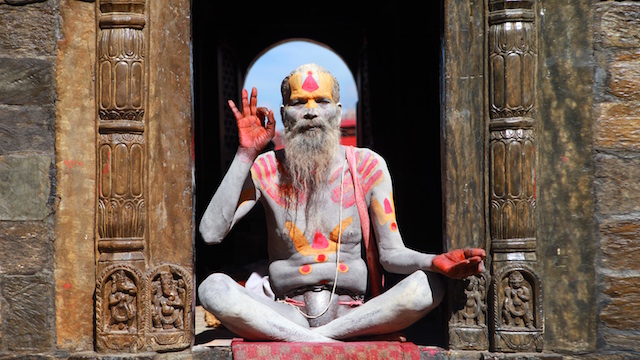There’s a growing epidemic in yoga culture: the infamous “guru” teacher.
Who is this guru teacher you might ask? The answer is complicated. My definition of a destructive guru teacher is this: any teacher who believes their own ability to heal others outweighs any student’s ability to heal themselves.
I started seeing a new yoga teacher back in the spring. She was bold, compassionate, and empowering—everything I could ask for in a teacher. I loved her cueing, I loved her inspirations, and I loved her sequencing.
It was a match made in heaven.
As a yoga teacher myself, it was a breath of fresh air to take a class from someone who I felt understood the core elements of teaching that went beyond the poses (asanas).
Not long ago, I attended a workshop this teacher was hosting. As always, I was thrilled to be in her presence. Near the end of the workshop, I suddenly realized: this teacher is not perfect. I am not perfect. Nobody is perfect!
There was nothing that she said or did that made me think this specifically. It was like my inner voice was sending me a warning sign. This simple yet powerful thought reminded me how harmful the guru archetype can be.
Anytime we put someone on a pedestal, we take away our own personal power.
And that’s a problem.
Don’t get me wrong, there are many inspiring souls out there with valuable knowledge. Guidance from them can be amazing. Having mentors and people out there motivating you to be your best self can be a major asset.
The problem happens when we place our personal power into someone else’s hands. And that’s exactly what materializes when a guru teacher takes advantage of a student’s vulnerability.
Any teacher has certain beliefs that guide them, both in teaching and in life. My philosophy is that you can present a student with information, but they must discover the truth for themselves. Forcing a student to conform to the beliefs of the teacher is a disservice.
Yet there is so much pressure for teachers to create an illusion of omniscience in order to achieve success.
Seeing this trend is heartbreaking. If anything, it encourages separation rather than the unity and connection yoga can offer. It also prevents students from seeking the ultimate power within themselves.
For a teacher, it can take a lot to let go of that essential human need to feel wanted, which is partly why the guru teacher is a widespread phenomenon.
Students are human; teachers are human.
If you’re reading this, you’re probably human too.
Even the yogis who are meditating in caves in the Himalayas are, in fact, human. We are all living this life and doing the best we can with the cards that we have been dealt. Making decisions, making mistake—it’s all a part of the process.
Having likes, dislikes, emotions, and experiences are all part of being human, which shouldn’t feel shameful.
This was true of my beloved teacher, too. Although I was infatuated with this teacher’s style and grace, she was still just a human, in spite of her many enlightened qualities.
There wasn’t any sudden trigger that caused me to question her perfection. In those brief moments, I thought, I wonder if she drinks. I wonder what she eats. I wonder if she makes mistakes. But do these things mean that her lessons made less of an impression? Of course not.
We can only hope that the people in our lives make the best decisions possible. This includes the teachers that provide guidance in yoga, meditation, or other areas.
I consider myself lucky to see this pattern clearly. The teacher I spoke so highly of never held her power over me. In my eyes, she is not the guru-type to watch out for.
However, that spark of admiration that I felt for her could have spiraled out of control, especially if that power had been put in the wrong hands.
Many teachers have taken advantage of that vulnerability in students who have put them on the pedestal.
To put someone in a place of power as a guru is actually the reflection of the perfection within.
No one is ever able to recognize any qualities without seeing it within themselves first. It is the interesting relationship that blossoms when projection and transference are at play.
Projection is casting the qualities of the self onto another person. If perfection is seen in another person, then it’s clear there’s perfection within the self as well.
Transference is a bit more complicated. It is transferring the emotions and qualities of another person onto a completely different person.
Years ago when I was in India, I had a few experiences with my yoga teacher that proved to be enlightening. I was frustrated with some of his teaching methods and frequently felt rejected by him, which was weird to me since I also caught myself seeking his approval.
When he gave me that pat on the back or that head nod with a smile, I found myself beaming. I soon realized this was similar to the relationship I had with my mother growing up. I never felt I was good enough unless I had her approval. I ended up transferring the tendencies of my mother onto my teacher, which resulted in the same dynamic.
So how can you spot the “guru?”
Since we have established the dangers of the guru figure, the question then becomes how we identify one. The answer echoes my definition—a guru is anyone who assumes that their power to heal others outweighs the individual’s ability to heal themselves. There are subtle ways that teachers exert power over others to put themselves in the seat of the guru.
They assume they know your body or your experiences better than you.
Have you ever been told what to feel, think, or experience in a yoga class? Even something simple, like being told what muscles you “should” feel or suggesting that something is “easy.”
The thing is, that teacher has never been in a different body.
They can only make assumptions based on their own experience. Experiences can be powerful, and they can be powerful to share with others.
However, projecting those experiences onto someone else can cause confusion or feelings of inadequacy. A student could be left wondering “wait, I don’t feel that way, is there something wrong with me?”
For all of you yoga teachers out there, have no fear! Be inspired to share your personal experiences without projecting them on your students. Feel compelled to use them to motivate others.
All other knowledge can be offered as a suggestion or a potential rather than a definitive response like “should” or “must.”
They project their own fears onto you.
Any reaction that sends the message “you aren’t good enough” from the teacher reflects the fears they feel themselves. During a class I took years ago a teacher snidely said, “Oh, you can opt out of this inversion if you’re on your period. Or you can play the ‘period card’ and pretend.”
It’s unfortunate this teacher felt it was their duty to single out certain students. At that point, there was no option to avoid the inversion unless I wanted the embarrassment hanging over my head.
Did I feel comfortable to honor my body or my practice? Of course not. I was essentially forced to conform to their idea of “perfect” while anything less than that was not good enough.
Although that statement still makes me shudder I have to remember that the teacher is also human. If anything, it presented an opportunity to be compassionate, as I recognized that fear is something everyone experiences.
Witnessing perfection and imperfection can be a great gift. Respecting and honoring other bright souls is more valuable than putting them on a pedestal.
In classes, be cautious of any teachers forcing their experiences and fears on others. Remembering everyone’s humanity opens the doors to find the inner voice encouraging inner strength and awareness.
These are the qualities that encourage connection to the true guru within each of us—the perfection we already have.
Author: Emily Kane
Image: Unsplash/Ashes Sitoula
Editor: Callie Rushton







Read 3 comments and reply